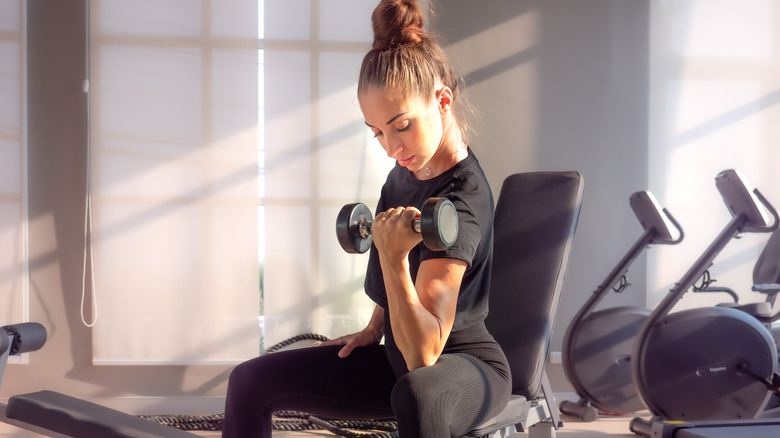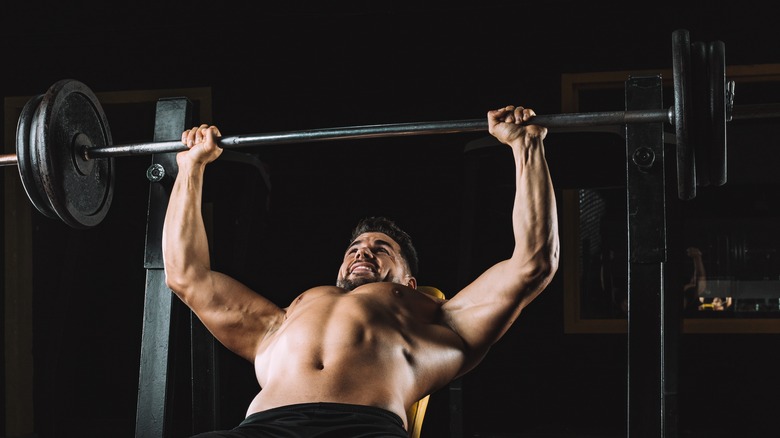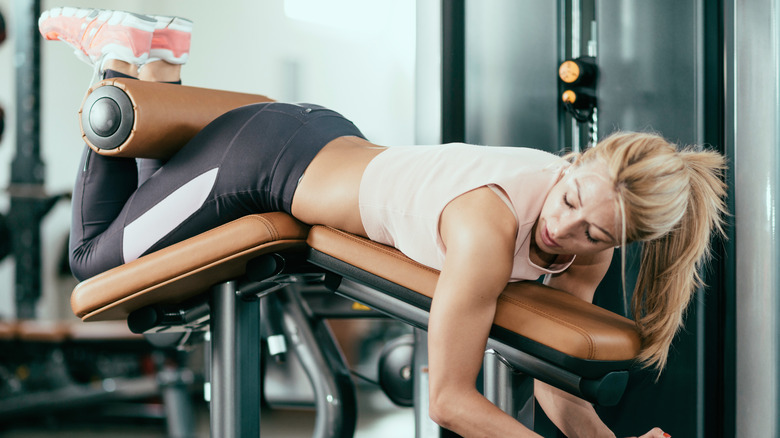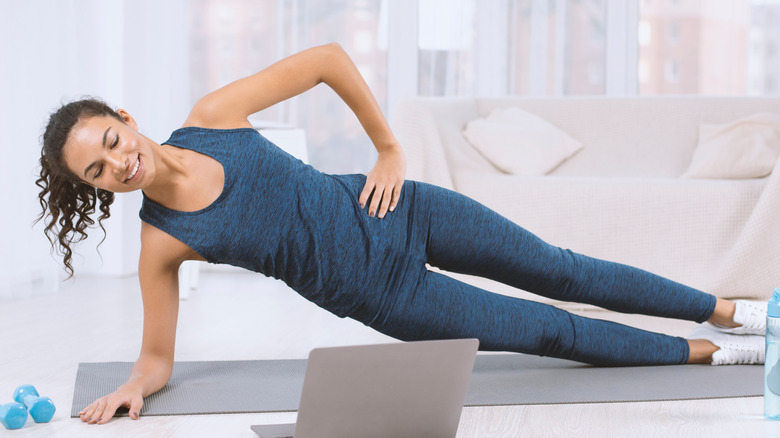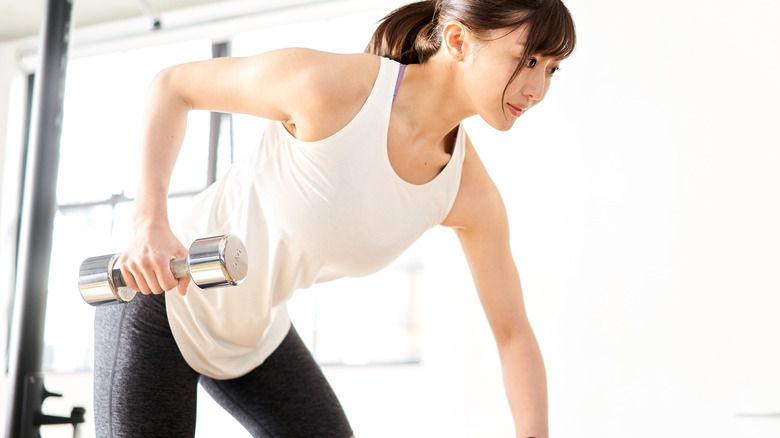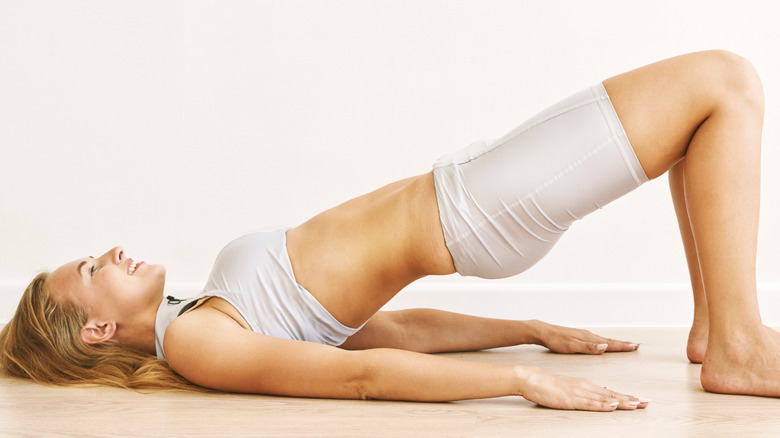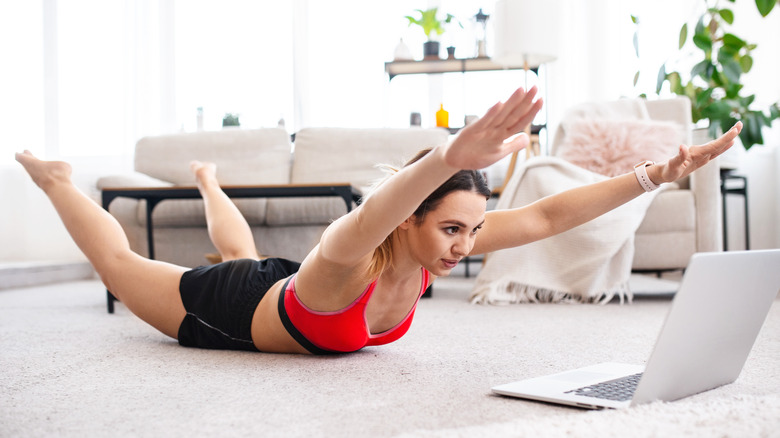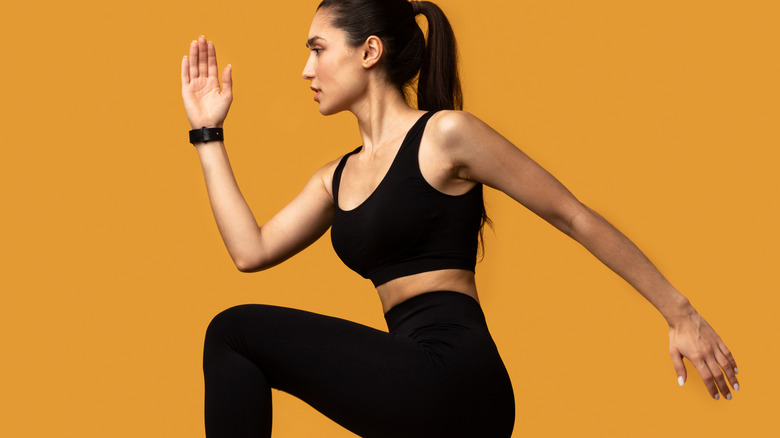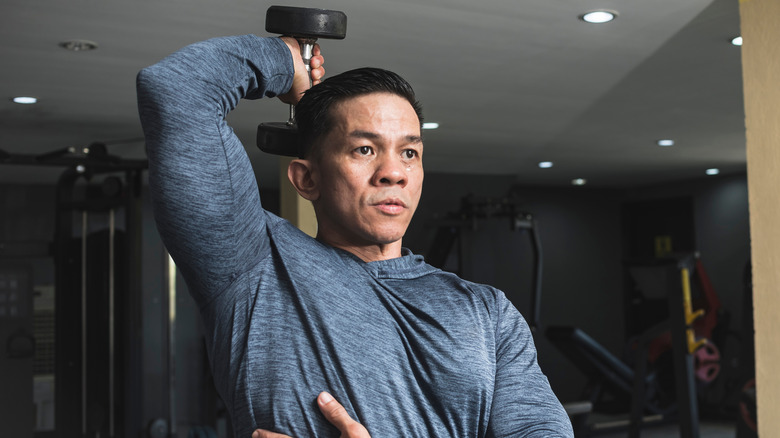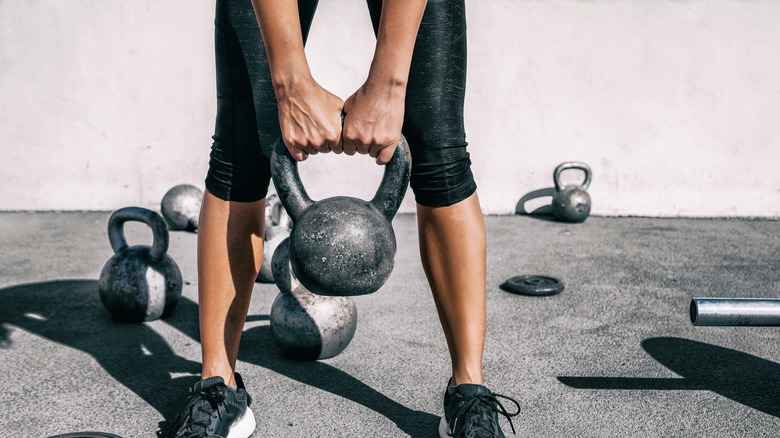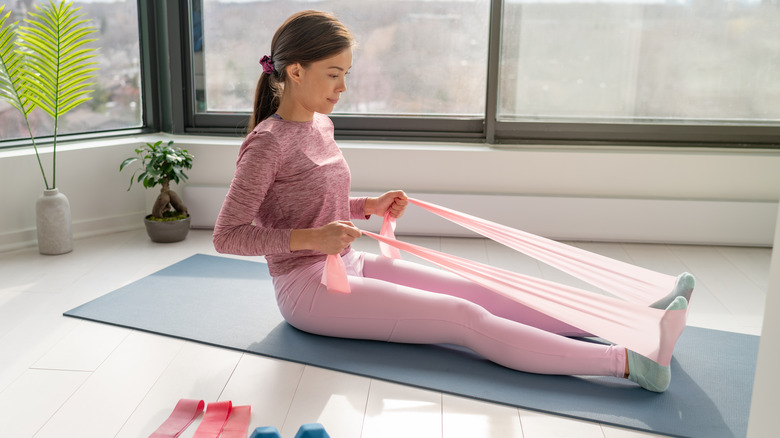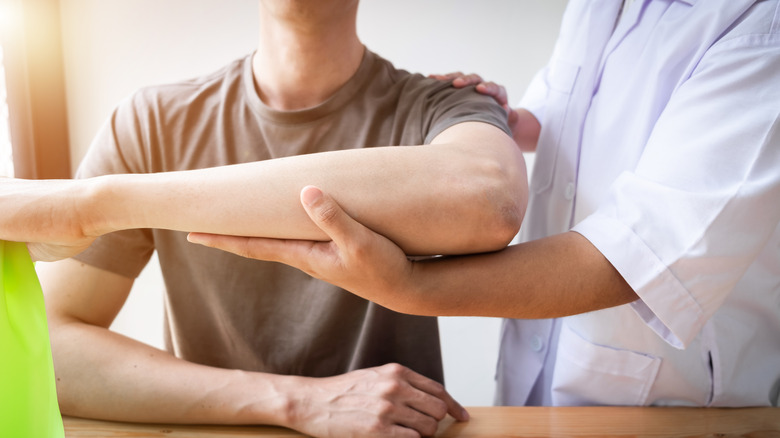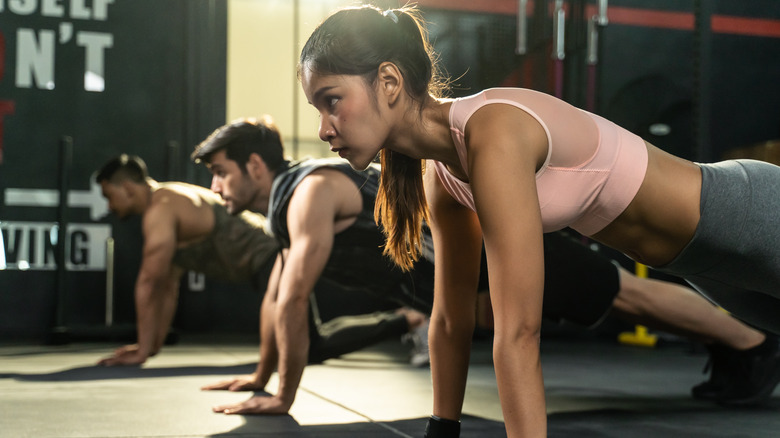Important Muscles You're Probably Ignoring At The Gym
Go into a gym and look around at what everyone is doing. Chances are you'll see many different exercises, but some will be more popular than others. The bench press or treadmills might be consistently occupied. You might see a group of people working their biceps or abs.
In your own workouts, think about the muscles you work and the exercises you enjoy doing. If you stick to the same routine, perform the same exercises all the time, or suffer from nagging injuries, you might be neglecting some muscles. The more you specialize in one activity, the greater your risk for injury, according to a study published in Pediatrics. The researchers found that athletes under the age of 18 were more likely to get injured if they only focused on one sport or activity. Adding cross training into your workout plan is a great way to ensure variety in your exercise regimen (via the American Academy of Orthopaedic Surgeons). For example, if you run a lot but never lift weights, you should incorporate weight lifting into your routine. The same goes for your gym routine. If you do the same thing all the time, you can develop injuries from overuse and excess stress on the muscles you're working.
Here are some of the muscles you might be ignoring during your gym workouts.
Agonists and antagonists
Your muscles are set up in pairs called agonists and antagonists (via Oregon State University). An agonist is a muscle that's doing the work, and an antagonist is a muscle that opposes the working muscle. It might seem weird to oppose a muscle that's trying to work, but you need some way to control your actions. For example, you don't want to slam your glass on the table after you're done drinking; you want to put it down gently. Agonists and antagonists follow that same principle.
This agonist-antagonist relationship works well most of the time, but if one of them gets too strong, your risk for injury goes up. A study published in the Journal of Strength and Conditioning Research explains that you need to maintain a balance between the strength of the agonist and antagonist to improve performance, avoid injury, and ensure joint stability.
Maintaining balance between muscles is key, but it's arguably not as fun in the gym. The bench press and squat are popular exercises, but you need to do rows and hamstring curls to balance them out. For the bench press, it's the chest working, so you'll need to work your back muscles to create balance. Squats make the quads work, but that means you'll need to work your hamstrings to balance things out.
General muscle imbalances
For people who engage in little to no physical activity on a regular basis, there are two main issues to watch out for, according to the Hospital for Special Surgery. They're called upper cross and lower cross syndrome. The first is a common postural problem where your head leans too far forward. The second is a lower back and hip problem where your lower back is arched too much. Both problems can be attributed to sitting and staring at a screen for too long.
These problems are caused in part by muscle imbalances. One side gets tight because it's too strong, while the other side gets weak. For upper cross syndrome, the chest is too tight while the upper back muscles are weak and loose. For lower cross syndrome, it's generally the glutes, hamstrings, and abs that can prevent the strong hip flexors from taking over and forcing the lower back to arch. Addressing these strength imbalances with strength training can get your body back into alignment.
Hamstrings
For female athletes in particular, the ratio of strength between the quadriceps and hamstrings is important to prevent injury. A study published in the Journal of Strength and Conditioning Research examined the ideal ratio of strength between the two muscles. They found that the hamstrings should be roughly 60 percent as strong as the quads. You don't need to go around measuring the difference between your muscles, but you should be aware that you can't slack on hamstring workouts.
Think about doing at least one hamstring exercise for every two quad exercises you do. Some hamstring exercises that work well are hamstring curls, stiff-legged deadlifts, and single-leg deadlifts. Not only will focusing on your hamstrings help prevent injury, it can also aid in other exercises where your progress might be stalling. Squats and deadlifts, for example, are two exercises where the hamstrings are involved. Performing these can help boost your strength in other leg exercises that aren't directly focused on the hamstrings.
Obliques
If you've ever suffered from lower back pain, you might've heard that it's helpful to strength your core or your abs. While those are beneficial instructions, it can be a little misleading. The abs are a group of muscles within the core. Per the American Council on Exercise, there are 4 abdominal muscles: the rectus abdominis, external obliques, internal obliques, and transverse abdominis. Each muscle does something different and can be trained in different ways.
Crunches and sit-ups target the rectus abdominis, as do many ab exercises. It's the most well-known ab muscle because it forms the famous "six-pack." On the sides of your abs are the oblique muscles, which run down from the bottom of your ribs into your hip bones. These large muscles help control your pelvis, and can prevent your lower back from arching or twisting too much. A study published in the Journal of Sports Science & Medicine showed that the V-Sit exercise works the obliques more than a group of other abdominal exercises. To do the V-Sit, perform a sit-up, but keep your feet off the ground and knees bent. At the top of the movement, only your butt should be on the ground.
Upper back muscles
To fix forward-head posture or slouching of the shoulders, try working on the upper back muscles. The traps and rhomboids are two of the main muscles in your upper back (via the Cleveland Clinic). Strengthening them will help balance out a tight and overworked chest that many fitness enthusiasts develop from doing too many push-ups and bench presses.
To work the upper back muscles, try doing any type of rowing motion. In an article that lists exercises for a healthy upper back, Kaiser Permanente recommends doing rows with a light resistance band. This might be too easy for some, but there are many options with free weights and cables. Barbell rows, dumbbell rows, and cable rows are all effective at strengthening the upper back. To properly perform rows, maintain an upright posture as you row the weight in towards your chest. Pull your shoulder blades together as you pull the weight back, squeezing them at the top of the movement. This fully incorporates your upper back muscles.
Glutes
Lower back pain can be partially attributed to weak glute muscles, says a study published in the Journal of Physical Therapy Science. In the study, the researchers had participants, all of whom suffered from lower back pain, try a training plan to strengthen either their glutes or lower back muscles. Both groups saw improvements in their pain.
The glute muscles are the large muscles of your butt, which come around to the sides of your hips. To strengthen them, you can start with a bodyweight exercise called the glute bridge. While lying on your back, press your feet into the ground and lift your hips up. Perform this exercise on one leg if that's too easy.
Meanwhile, band walks strengthen the gluteus medius, a smaller muscle on the side of your butt. Place a resistance band around your ankles and walk sideways. Other glute exercises that add resistance include the squat, deadlift, and split squat. Since the glutes are so strong, adding weight to exercises will target them more effectively and help build strength.
Lower back muscles
Strengthening your lower back is another way to reduce lower back pain, according to the Cleveland Clinic. Exercises like the deadlift work your lower back muscles, but that can be too stressful on your back if you're in pain.
You use your lower back muscles to lift objects (per Cedars-Sinai). That means movements such as a deadlift in the gym or lifting boxes at home use the muscles that run down the back, such as the erector spinae. Still, it's important that you work these muscles to maintain stability in your lower back. They also make exercises like the squat and deadlift safer because your lower back can handle more strain.
For a bodyweight lower back exercise, one option recommended by the Cleveland Clinic is the superman. Lie on your stomach with your arms and legs stretched out. Lift both your arms and legs, hold them off the ground for a second, them lower them. It's worth noting, however, that some trainers actually discourage people from doing this exercise; as performance specialist Matt Cheng told BestLife, "this exercise forces our lower back to overextend repetitively and only contributes to bad patterns and more back pain." Feel free to check out these alternative back exercises instead. You can also use the back extension machine at the gym, which gives you the option of holding weights.
Diaphragm
Muscles do more than just lift weights. Perhaps the most important muscle in your body, the diaphragm makes breathing possible (via Penn Medicine). The diaphragm sits under the lungs and, when it's relaxed, pushes into the lungs. When it contracts, the diaphragm flattens and makes room for the lungs to expand. Without the diaphragm, breathing would be impossible.
Obviously, you can't lift weights with your diaphragm. You can, however, practice proper breathing techniques. Strengthening your diaphragm with these techniques will help you breathe more efficiently, something that can help all fitness enthusiasts. It's also a tool to relieve stress.
Here's a simple breathing technique: As you breathe in, press your stomach out. Try not to expand your upper chest when you breathe in. Rather, breathe into your belly. If you can breathe into your belly, you'll activate your diaphragm more, strengthening it over time. Harvard Health suggests practicing this style of breathing while lying on your back. You can also do it while sitting in a chair. These relaxed positions will help you concentrate and perform the exercise properly.
Hip flexors
The hip flexors are a group of muscles that you can't really see. That might be why they're not often talked about in a gym setting. It's easy to forget about muscles you can't see, but training your hip flexors could help sports performance. A study published in the Journal of Strength and Conditioning Research found that people who increased their hip flexor strength improved their sprinting speed.
There are a few muscles that make up the hip flexor group, states the American Council on Exercise. They're found between the lower back and pelvis, down into your thigh. The longest hip flexor muscle runs down to your knee. One way to train these muscles is with hanging knee tucks or leg lifts. An added benefit to these exercises is that you train the abs as well.
Another way to train the hip flexors is with a kettlebell. Put the front of your foot through the handle of a kettlebell and, while keeping your foot flexed, lift the kettlebell off the ground and bend your knee.
Triceps
Biceps get a lot of attention at the gym, but you shouldn't forget about the triceps. The muscles that run down the back of your arm are surprisingly useful, and strengthening them has a lot of carryover to other exercises. The triceps are used in most pressing motions, like the push-up and shoulder press. They're also used in some back exercises like the pull-up and lat pulldown. Their versatility makes them an important muscle.
You can work the triceps directly by doing things like triceps extensions and kickbacks. You can also work them in a more functional way with exercises like the close-grip bench press and the dumbbell pullover. According to the American Council on Exercise, triangle push-ups, performed with your hands close together, activate the triceps more than pushdowns or kickbacks. If those are a little too difficult, try doing them from your knees and working your way up to the full version with knees off the ground.
Forearms and grip strength
Many weightlifting exercises require grip strength, even if you don't notice your forearms working. Deadlifts are one example, but exercises like the lat pulldown and dumbbell lunges work your grip as well. As your muscles get stronger and you can lift more weight, your grip might lag behind. If that's happening, it's time to think about training your forearms.
The muscles that control your grip are located in the forearm and run all the way up to your elbow. To work your grip, you'll be working those muscles of the forearm. You can either work them directly with forearm curls and extensions, or use more functional grip exercises. The National Institute for Fitness and Sport recommends the farmer's carry to improve grip strength. To do this exercise, grab a pair of heavy kettlebells or dumbbells. Walk slowly, maintaining an upright posture, for a set amount of distance or time. To make it harder, use more weight or carry them a greater distance.
Posterior deltoid
Most exercises for the shoulder target the front and side of the shoulder, but there's a third side that doesn't get enough attention: the rear. The back of your shoulder is used in different exercises and requires special attention to keep it strong. Creating balance between all three deltoid muscles can help keep your shoulders healthy.
To work the posterior deltoid, the American Council on Exercise recommends two exercises. The first is a seated rear deltoid fly. To do this, grab two dumbbells and sit on the edge of a chair or bench. Start with the dumbbells next to your ankles, and lift your arms out to the sides. The other exercise they recommend is a row. Rows are essentially the opposite of a bench press, meaning you get the added benefit or working the upper back muscles that help balance out the strong chest muscles. Incorporate both exercises into your routine to balance out your shoulders.
Rotator cuff
The rotator cuff is a group of small muscles that surround the shoulder. They keep the shoulder joint stable, but excess strain can cause an injury or tendinitis. If you're experiencing shoulder pain, rotator cuff exercise can help. A sytematic review published in the British Journal of Sports Medicine showed that specific exercises (including those focused on the rotator cuff) are superior to general shoulder exercises when it comes to dealing with pain.
That said, even if your shoulder doesn't hurt, strengthening your rotator cuff can help prevent injury. There are 4 rotator cuff muscles, so you'll need a group of exercises to work every muscle. In general, you should have one internal rotation exercise, one external rotation exercise, and one horizontal abduction exercise. For each exercise, you should use light weights. The rear deltoid fly counts as a horizontal abduction exercise, and you can do a band-resisted internal and external rotation to round out your rotator cuff strengthening program.
The American Academy of Orthopaedic Surgeons recommends doing a standing internal and external rotation with your elbow by your side, bent at 90 degrees. You simply turn your hand in towards your stomach to do an internal rotation, then away from your stomach for an external rotation.
Making a plan
Keeping your workout plan balanced can help you avoid favoring certain muscles. According to Harvard Health, you should work each major muscle group at least two to three times per week. Sticking to that plan will keep you from favoring muscles and throwing your body out of balance.
To work every major muscle, break your workout down into movements. Think of the bench press as a pushing motion. The opposite of a pushing motion is a pull, so you should try to balance out every bench press exercise with a rowing exercise. The opposite of a squat, which works the quads, is a deadlift, which works the hamstrings and glutes. Every exercise has an opposite movement, just like each agonist muscle has an antagonist. The more balanced your workout routine is, the fewer muscles you'll neglect. Over time, you might find that the exercises you were skipping in the gym were actually holding back your progress.

